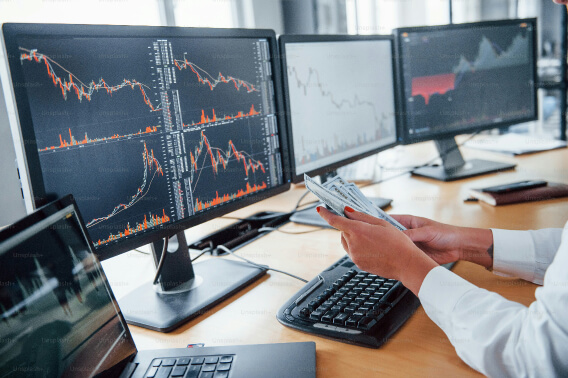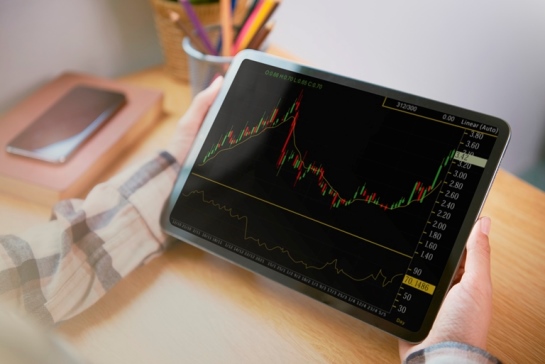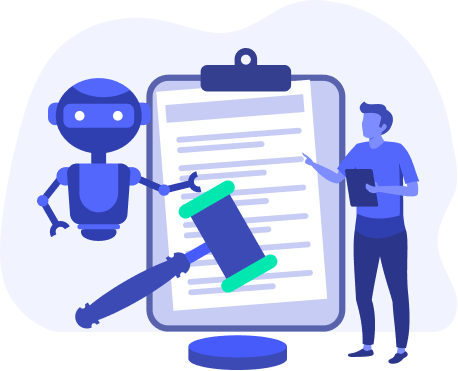Algo Trading
Algo trading harnesses advanced algorithms to execute trading strategies with unparalleled precision, catering to traders seeking to customize their approach for a tailored trading experience. This innovative trading form allows individuals to leverage broker-provided API keys, granting access to automated operations that transform complex strategies into seamless actions.
Algo trading, gaining momentum for its arility to simplify trading through technology, enables even those without programming skills to participate effectively. Traders can back-test strategies confidently, ensuring their moves are both smart and strategic. As algo trading becomes increasingly popular, it represents the future of trading, offering a platform where strategies are not just executed but optimized, marking a significant shift in how trading success is achieved and redefining opportunities in the financial markets.
Open an Account & Start Algo Trading Today!
- Flat Rs 18 brokerage
- No Cost Algo Trading
- 30+ Indicators
- Trade from Chart
- Stock SIP
- Bigul Option Chain
- 300+ Pre Defined Market Watch
- Basket Order
Purpose of Algo Trading
The purpose of algo trading is to elevate trading efficiency and precision by leveraging advanced algorithms to automate and optimise trading strategies. This technology enables fast execution of orders, surpassing human capabilities and allowing for high-frequency trading at an unprecedented scale. It significantly reduces the risk of emotional decision-making and human errors, integrating sophisticated risk management tools for smarter, more strategic trades.
Algo trading democratizes access to the financial markets by simplifying complex strategies, making it accessible even to those with minimal programming knowledge. Ultimately, it aims to reduce operational costs while providing the flexibility to adapt strategies in real-time, ensuring traders can maximize their market potential and investment returns efficiently.

Benefits of Algo Trading
Fast Execution of Orders
Supercharge your trading! Algorithmic trading, driven by lightning-fast computers, slashes order execution time. Experience the pinnacle with high-frequency trading, enabling traders to make tens of thousands of trades per second.
Automation
Unlock automated trading magic! Pre-programmed algorithms crafted by skilled programmers oversee operations seamlessly—from monitoring to trade execution, eliminating human intervention.
Risk Management
Level up from emotional decisions! Classic traders retain manual control, risking emotional choices and potential losses. Algo trading integrates risk management for strategic precision.
Cost Reduction
Invest wisely! While the initial setup of algo trading may be costly, its long-term efficiency slashes operational expenses, minimizing transaction costs and ensuring a cost-effective trading journey.
Human Error
Most human errors! Algo trading eradicates mistakes like wrong inputs, forgotten stop-loss, and emotional decisions. It ensures flawless execution, freeing you from pitfalls and enhancing overall performance.
Free Algo Trading Software
Code your success! Algorithms crafted by programmers need timely updates to align with market shifts. Enjoy the freedom to modify and thrive!
Pre-Built Strategies
Take your trading prowess to the next level effortlessly with our Pre-Built Trading Strategies—meticulously crafted and ready to deploy, offering a shortcut to success in the dynamic world of financial markets.
Calendar Spreads
4 Min read | 23 Sep 2023Explore calendar spreads in Algo trading! This strategy involves holding a long and short position with the same strike price and expiration date but across different months. The forward month helps hedge the initial option's price risk, providing flexibility for adjusting or exiting spreads before expiration to adapt to market shifts.
Read more
Order Slicer Strategy
4 Min read | 23 Sep 2023Maximize market impact with the Order Slicer strategy, involving breaking a large order into smaller, manageable parts executed gradually to reduce the risk of adverse price movement. This strategy reduces market impact, improves execution efficiency, and helps traders maintain control over their trades.
Read more
Call Executor Strategy
4 Min read | 25 Feb 2024Harness the power of automation with Call Executor—an Excel-based algorithmic strategy offering real-time data utilisation. Accessible and affordable, it empowers traders with rule-based, automated executions. Capitalise on Excel's data connection capabilities for up-to-date insights on stock prices, volumes, and economic indicators, informing strategic decisions. However, be mindful of Excel's limitations, particularly in high-frequency or extensive market data scenarios.
Read more
Scalping Trading Strategy
4 Min read | 23 Sep 2023Scalping, a day trading strategy, involves quick buying and selling of a single stock to make small profits across numerous deals in a short period. Scalpers prioritise technical trading over fundamental analysis, focusing on historical price patterns and current trends. Using ultra-short timeframes, as brief as five seconds, scalpers make 10 to 100 trades daily. Scalping stands out for its emphasis on rapid, technical trading techniques, distinct from other methods like position trading.
Read more
Multi-Leg Strategy
4 Min read | 25 Feb 2024Optimise your options trading with multi-leg orders—simultaneous trades involving different strike costs, expiration dates, or asset price preferences. These orders, like spreads and butterflies, aim to trade amid volatility. Pros include potential loss limitation through strategic planning.
Read more
Trend Trader
4 Min read | 23 Sep 2023Embrace trend trading for strategic gains! This popular strategy involves identifying and capitalising on sustained market trends, be it bullish or bearish. Traders align with the trend, buying long positions in an upward trend and selling short positions in a downward trend. Trend traders adopt a long-term perspective, utilizing technical indicators like moving averages for informed decisions.
Read more
Candle trading strategy
4 Min read | 25 Feb 2024Unlock the power of candlestick patterns in quantitative trading! These simple formations offer easy interpretation, making them valuable for traders. With a basic understanding of candlestick formation, quantitative strategies leverage open, high, low, and close price fluctuations in various tradable instruments. The master candlestick strategy, a breakout technique, identifies new price ranges, anticipating significant fluctuations post-breakout.
Read more
What We Offer
- Virtual Trading
- Backtesting
- Strategy Builder
- Execution Algo
- Multiple Segment
- Prebuilt Trading Strategies
How Algo Trading Works?
Algo Trading completely works on the conditions and parameters designed and coded by the user. It is a process of executing orders utilizing automated and preprogrammed trading instructions to account for variables such as price, timing, and volume.
Let’s understand it with an example: Suppose a trader wants to deploy an option selling strategy; firstly, they will design the strategy after writing down all the possible conditions of the strategy; later, it will be fed to the program for the best possible result. Let’s say straddle but with some adjustments by us – one of the most popular option selling strategies, the possible conditions that could be fed to the program for the best possible result.
- Sell 10 lots of Call and Put of ATM premium of NIFTY50 index on expiry at 9:30 AM.
- Stop loss will be placed on the 50% increase in the premium value or at the break-even points.
- Stop loss can be trailed on every 25% – 30% Decay in premium value.
- Target will be booked as soon as the premium value is not more than 10% of the selling value of the premium.
These instructions will be coded into one of the following languages: Python, Java, C++, R. Using these given instructions, a computer program will automatically monitor the spot as well as the premium price and place the buy and sell orders when the defined conditions are met. The trader no longer needs to monitor live prices and graphs or put in the orders manually. The algorithmic trading system does this automatically by correctly identifying the trading opportunity. The core mechanism of algo trading is nothing, but the program will do trading on your behalf.
Technical Requirements for Algorithmic Trading
Algo trading is completely based on a program, which means, obviously, there is a technical portion in the setup of the environment. Implementing the algo using a computer program is the last component of algorithmic trading, accompanied by backtesting (testing out the algorithmic strategy on historical periods of past stock-market performance to check the performance to determine whether the strategy is profitable or not). The challenge is to transform the created strategy into an integrated program that has access to a broker side for punching the orders. The following are some prerequisites for algorithmic trading:
Computer Skills
Computer-programming knowledge is necessary to self-build an algo strategy program, hire a programmer who can code your strategy and deploy it on the server, or use pre-made trading software.
Internet Connection
It is necessary to have internet connectivity and access to trading platforms to place orders. Keep in mind the server connectivity from the cloud and broker should also be fine for smooth transactions.
Access to Market Data & API
The programmer should have API keys and proper access to market data, which must be monitored by the algorithm for continuous looking for opportunities to place orders.
Historical Data
An algo creator should have past data to run and test the available historical data, depending on the various market conditions and complexity of rules implemented in the algorithm.
Ability to Test
The ability and infrastructure to backtest the algo system once it is built before it goes live on real markets. It is necessary to backtest the strategy and see the RR, POP and other factors before making its algorithm.
High Execution Process
Utilize distributed databases and parallel processing techniques to store and analyze large volumes of market data efficiently. Cloud servers would be the best choice for fast execution of orders.
Algo Trading Time Scales
Algo trading is implemented across several time scales based on an individual’s investment needs. The time scale is just a factor of an individual’s choice and the type of trader; it can be changed accordingly from person to person. The factors that could affect the decision are events, market conditions, market segments, and many other factors.
Let us discuss the different time scales mentioned in algorithmic trading:
Low-Latency Trading
Slow execution can lead to missed opportunities, and traders struggling with latency may be losing money.
High-Frequency Trading
High-frequency trading (HFT) is algorithmic trading implemented by relatively high-speed execution.
Intraday
Many intraday traders place orders between seconds and minutes through algorithmic trading.
Swing Trading
Swing traders take advantage of the market’s short- to medium-term price movements.

Algo Trading in India and its Legality
The SEBI (Securities and Exchange Board of India) approved Algo trading in India in 2008. In the beginning, only institutional investors, such as mutual funds and insurance companies, were allowed to do it, but now, even retail investors are allowed to deploy their strategy completely onto Algo software. Lots of broker and fintech companies offer a way to do Algo trading through an Application Programming Interface (API).
Users can either create their own trading strategy based on their conditions or pick one that's already set up by the Algo platform providers like Bigul. According to the 2018 report from NIFM, 50% of all clients' trades are done through Algo software, and about 40% of proprietary trades use it, too. In more developed markets, Algo trading makes up about 80% of all trades.
Conclusion
For a classic manual trader, shifting to algo trading will be an amazing experience. Algo trading, in a nutshell, is a concept where a trader deploys its strategies and concepts into a program where the overall operations, from monitoring to managing orders, are completely managed and operated by algorithmic software specially designed to perform certain tasks. It is not necessary for algo traders to give 100% of their control to their program; it can be customizable according to the needs and necessities of the trader.
It is a mathematical model developed by programmers and is fed into a computer in a certain way so that they can perform well in their trades without causing any human errors such as delay in execution, human errors, bid-ask deviation entries, etc. As the broker provides the API key to their clients for accessing and enabling the algo trades, basically, it is a complex process to make the overall environment of algo trading setup, which requires professional knowledge in finance and programming to make your strategy fed into a computer for smooth running without any unwanted or unbearable risk into the orders and for any individual but you can make and backtest your strategy without programming knowledge.
Looking to streamline banking
operations with automation
technology?
Loading..





25%
increase in close rates
5x
response rates with video
50%
shorter deal cycles
4x
lift to monthly SQOs
Generate Videos in Minutes with AI Avatars
Generate personalized sales videos for every prospect with an AI Avatar that looks and sounds just like you.